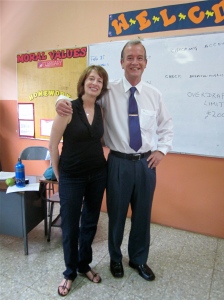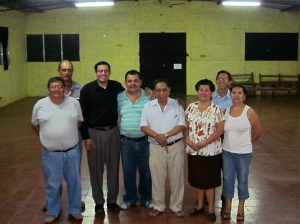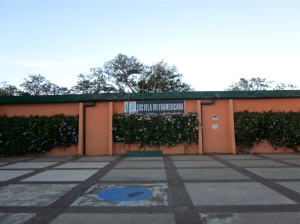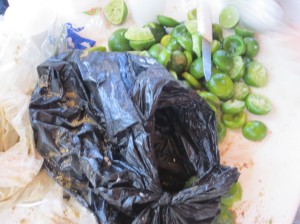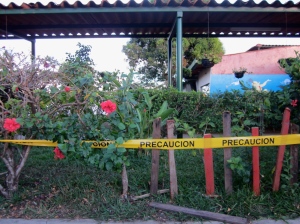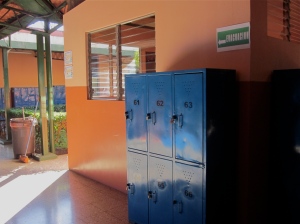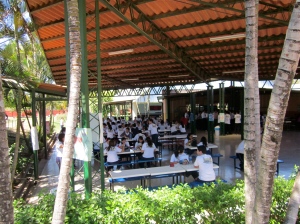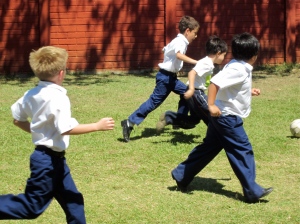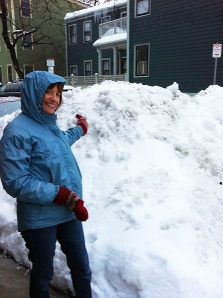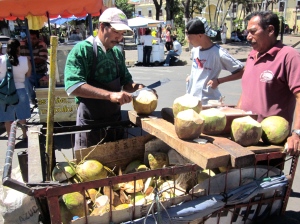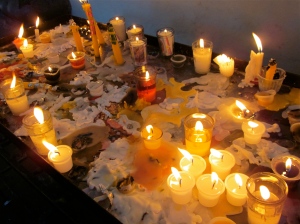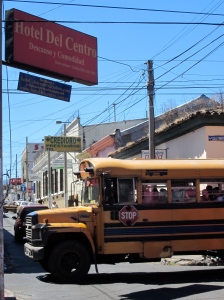
Water Fountain Version 1

Water Fountain Version 2

Water Fountain Version 3
Often I’ll see websites that have two similar pictures side-by-side with a caption underneath that reads: “What’s the big difference?” The idea is that the viewer will then look for small changes in the images presented. I ask that you do the same with the pictures above. All three are pictures of water fountains at schools in El Salvador, but there are some clear differences in the images presented. So, easy answers include: one has plants in it, one has kids in it, one has a hand sanitizer next to it.
Having taken these photographs myself, I can tell you that the differences are far greater than they appear. For me, these images symbolize the vast gap, in terms of economics and education, that exists in El Salvador. This gap exists in the United States as well, though it’s not something that is highly focused upon unless its an election year. Sorry, I will try to keep these views to a minimum. Here are a few numbers from 2005 that will provide an understanding of the distribution of wealth in El Salvador: 20% of the people live in extreme poverty–living on less than $1.00 a day. Without “remittances,” money sent to El Salvadorians from relatives living outside the country, the poverty rate would be around 37%. In fact, through most of the twentieth century the wealth in El Salvador was controlled by only 2% of the population.
Water Fountain Version 1 is located at my host school, Escuela Interamericana, a private school serving primarily upper to upper middle class families, serving approximately 330 students. Tuition is $180.00 per month.
Water Fountain Version 2 is located at Colegio Bautista, a private school serving primarily middle class families, serving approximately 400 students. Tuiton is $55.00 per month.
Water Fountain Version 3 is located at Centro Escolar Tomas Medina, a public school serving approximately 1,785 students. There is no tuition.
As is the case here in the United States, the quality of education and facilities vary tremendously in El Salvador. I knew that Interamericana, my host school, was a private, bi-lingual, college preparatory high school, creating an image in mind of to expect. I wasn’t surprised to see immaculate grounds, a fully stocked tech lab, and fairly motivated students. In general, the students were often smiling as they crossed the campus, dramatically waving at me and cheerily calling, “Hello, Miss Julie! Are you going to be teaching this morning?” or “Buenos dias, Miss! What else are you exploring in El Salvador today?” In turn, they eagerly “volunteered” to pose or inquired about what I had experienced in their country Their energy and enthusiasm were infectious, as was the tremendous pride they have in El Salvador. Many proclaimed their love for their country–its people, its food, its culture.
I knew that my experience at Interamericana would be a bit different than my day-to-day teaching in Boston within minutes of my first class. When I entered the room, the students immediately quieted down, at times a rarity in my classes in Boston, and took out their notebooks. Next, when I greeted them all with a “Good morning,” the students responded in unison, “Good morning, teacher.” Shocked by this enthusiastic greeting, I repeated my words. Once again, the students greeted me just as they had the first time. If I thought I could, I probably would have repeated this “dialogue” for the remainder of class. I can probably count on one hand the number of times that I’ve been greeted in this manner by students in my twenty years of teaching.
When my host teacher, Benjamin, said that he would like me to teach on the first day, I admit that I was a little surprised and a bit panicked. I thought that I would have a day to acquaint myself with the school– ah well! The focus topic for my first class was events leading to the outbreak of World War II. So, I have never actually taught a lesson on WW II. Benjamin seemed fairly relaxed about this matter, simply providing me with the textbook and guiding me to the pages covering this period. Now I was presented with dilemma number two–a textbook. Though I often take readings from various sources, textbooks included, I do not use a standard textbook on a regular basis. One of the aspects of my profession that I love is creating curriculum. I would find it very stifling if my teaching experience consisted of moving chapter-by-chapter through a textbook or to primarily use pre-made assessments and guides. I love to look for connections between history and current issues in the world. I love assessments that provide students with the opportunity to apply what they’ve learned to their own lives.
Given that I had only a short period of time in which to develop a focus for class, I went back to the good old “objective”–What did I want students to know and be able to do at the conclusion of the class? I wanted students to be able to think about the significance of the events leading to WWII, rather than my merely telling them what was significant. I realized that my style might be a bit different for students, as the lecture format appeared to be the favored style of the classes I had observed that morning. With my objective in mind, I decided to focus on Cornell Notes, which helps students think about the questions that go along with “answers” of historical events, and “jigsaw” reading, which allows students to be experts about a particular area of the reading and results in student led, rather than teacher led, discussions.
After modeling the approaches we were going to use in this work, the students divided into expert groups to begin questioning and reading. For many this type approach, student as expert, proved a bit daunting. Yet, after a bit of encouragement and practice, they began to trust in their ability to determine what information was important. Unfortunately, time did not permit us to finish the reading on this day, but it the students were very excited about being given ownership for their learning. Strangely enough, after I thanked the students for their willingness to push their comfortable limits during our work, the entire class began applauding. I was really in shock! I asked Benjamin if he had told the students to do so, he assured me that he had not. In addition to the applause, students made a point of telling me how much they enjoyed the class and thanked me for working with them.
This experience was continued throughout my time at Interamericana. I truly found the students interest in my techniques and ideas about teaching and learning “refreshing.”
Fortunately, I had the opportunity to visit two other schools while in Santa Ana. My host attended the Colegio Bautista, so he was able to set-up a tour with the principal. Interestingly, though this school costs less to attend than Interamericana, the facilities and approaches to teaching, in particular the new “language wing” where students focus on strengthening their skills in English, quite impressive. The majority of the students are from middle to lower income families, as the school offers quite a few scholarships for those unable to afford the tuition. I did not teach a lesson in this school, but in my observations it was evident that the majority of the teachers were well trained, for they tended to rely less on following a textbook and more on engaging learners through well-developed curriculum. There was far less focus on lecturing and far more focus on small group work and discussions. As a learner, I know that this school would definitely push my comfortable limits and allow me to be an active participant in my learning.
I also found the principal at Colegio Bautista to be truly dedicated to strengthening the learning opportunities for students. He outlined the plan to further increase use of technology, though there were clearly more computers and Smartboards than at Interamericana (sorry). In turn, he discussed the importance of having students not just learn academics, but to also understand the importance of understanding one’s role within society and how one might contribute. His passion for his work was evident throughout our time together. One piece that I loved was that he pushed me to speak in Spanish. I do not, as I’ve previously written, speak the language, so I appreciated his attempts to help me communicate in Spanish. When I mispronounced something, he patiently repeated the word until I was able to pronounce it correctly. Clearly, he is a true teacher!
My final school visit was to Centro Escolar Tomas Medina, a public high school in Santa Ana. Though, unfortunately, my time was short at Centro, it was at this school that I met the teacher with which I most identified, Teacher Ana Elisa Jimenez de Rivas. She is a truly amazing educator who loves her work and cares tremendously for her students. Note: Ana has 40+ students per class as compared with an average of 22-28 in the other schools outlined. Her work is definitely more in line with mine than either of the other schools I visited. Ana works with students who live in very unsafe conditions. Many of the children’s family members have experienced violence at the hands of gangs or are themselves gang members. In reality, though the school is K-12, many of the students will leave by ninth grade to either work to help support their families or join gangs in order to survive. In Boston I’ve had similar experiences with families, but I do believe that we’re beginning to see a shift, to some extent, in regards to the influence of gangs in the lives of students. Unfortunately, with the economy stalled in the US, many of my students are finding themselves working more or acting as a caregiver for younger siblings. So, it is with Teacher Ana that I felt most comfortable and with her I wish that I could have spent more time.
I felt that students at Centro were a bit more guarded when they met me and when I asked to take pictures. Though I’m not sharing these photos, if you were to compare them, just as you would those of the water fountains above, you would understand what I’m attempting to convey about the demeanor of these young people. Yet, I understand their uncertainty, for, as Ana explained, many of these students struggle to make it to and from school. Thus, Ana has taken it upon herself to organize study groups to insure that students are together in groups in the safety of the classroom or at a home, for being alone, whether on their way home or in their homes, creates a tremendous risk to their well-being. Another piece that stood out for me in this school was the lack of resources, especially when compared to that of the private schools I visited. Since Centro is a public school, the government is supposed to provide students with supplies, 10 pencils and 6 notebooks, at the beginning of the school year. By the time that I visited school had been in session for several months and students still did not have supplies. As a result, many students were reusing paper from the previous year, vigorously erasing any notes they had written.
My experience at Centro was probably one of my most profound during my time in El Salvador. I definitely believe that Teacher Ana is one of those kindred spirits that you read about, but yet you never truly believe that such a person exists; however, given that we communicated immediately after my exchange and that the members of my learning community were extremely interested in her work in El Salvador, I know that we will continue to share our work with one another.
So, though the initial images of this post appear to simply be water fountains, they do symbolize a great deal more. They’re representative of the very different resources and educational experiences that are available to the young people of Santa Ana. As I’ve experienced in my own work, the economic situations and environmental influences of the students will greatly determine the paths of their lives. Teacher Ana stresses to her students the importance of education–that it is a way to improve their lives–but she, too, understands that this promise is often overshadowed by the realities of needing to survive in El Salvador.
Aside: Remittances appear to be tremendously helpful in lowering the poverty rate in El Salvador; however, while there I noted long lines outside a few buildings one day. When I asked Benjamin what the lines were for, he explained that the people were “waiting for money from family in the U.S.” Furthermore, in many instances those who travel to the U.S. end up leaving family members behind, usually young children, with other relatives. I can’t help but wonder what it would be like as a child to have little to no contact with my parents for months or years at a time. I know there will be those who want me to comment on immigration in the U.S. here, both legal and illegal, but that’s not the focus of my observation. Sorry!
The other area in which I noticed the impact of remittances was at the grocery store. When I went shopping with Benjamin and Amy, his most wonderful wife, they were buying beans to have with dinner. As we walked a package of dried beans, I said to Amy, “Oh, that’s what I usually buy, soaking them overnight and cooking them the next day.” She replied, picking up a package of pre-prepared beans, “That’s what we used to buy, but they’re too expensive now. Plus, with the cost of gas for the stove being $13.00 a month, cooking them just adds to the expense.” Showing me the package of beans in her hand, I noted that the price was $1.50. I then looked at the bag of dried beans and saw that the price was $4.50. Really? I can buy dried beans for around $1-2.00 a bag! So, if Amy were to buy dried bean and cook them, she would probably spend about $4-5.00 more per meal! That’s a tremendous difference, especially when you’re living on a teacher’s salary in El Salvador ($150-250 month) and trying to feed a family of five! In doing a little research, I discovered that the price of food has increased dramatically, primarily due to the influx of remittance funds.












